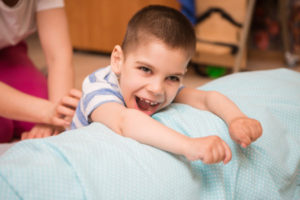Understanding a Cerebral Palsy Diagnosis

If a doctor gave your child a cerebral palsy diagnosis, you probably have questions.
A cerebral palsy diagnosis by a doctor confirms that your child has a set of permanent conditions due to an injury or infection caused by or present at birth.
Most children with cerebral palsy are diagnosed during their first 2 years of life. However, if symptoms are mild, a health care provider may not be able to make a diagnosis before the age of 4 or 5.
A doctor may not be able to tell you the exact reason why your child developed cerebral palsy. In some cases, cerebral palsy can stem from negligent medical care or a mistake made by your doctor, midwife, or nurse during the birthing process.
A cerebral palsy diagnosis also comes with a prognosis. A prognosis is a doctor’s educated guess on the short- and long-term outcomes of their condition. Whether the prognosis indicates severe or mild cerebral palsy depends on the specific signs and symptoms.
Signs and Symptoms That May Lead to a Cerebral Palsy Diagnosis
Doctors look for different signs and symptoms when diagnosing cerebral palsy.
Signs and symptoms that may lead to a cerebral palsy diagnosis are:
- Missing developmental milestones
- Abnormal or involuntary movements
- Abnormal facial expressions
- Paralysis in parts of the face or limbs
- Trouble in sitting, standing, or walking
- Contracted joints in arms, legs, or trunk
- Inability to speak
- Lack of muscle control which causes tremors, twitching, or shaking
- Too much or too little muscle tone
- Abnormal posture
- Lack of balance
Cerebral Palsy Assessments
A cerebral palsy assessment will examine your child’s physical symptoms to determine if they have the condition. An assessment includes a head-to-toe physical, along with an overall evaluation of growth and development.
In a physical assessment, muscle tone, balance, and movement control will be evaluated. More detailed assessments of hearing and vision can be done as well.
Unless your child’s cerebral palsy is severe, symptoms may take months or years to become apparent. Careful observation of developing motor functions is needed to make an accurate assessment.
Physical symptoms of cerebral palsy to watch for include:
- Abnormalities in muscle tone, movement, and reflexes
- Obvious preference in using one hand over the other
While observing motor skills is usually an accurate way to diagnose cerebral palsy, your doctor might order more tests to rule out other disorders. For example, other tests could include CT scans, an MRI, and head ultrasounds.
These tests can reveal serious conditions that may have caused these symptoms, such as fluid in the brain, brain cysts, or scars.
Assessing Developmental Milestones
If cerebral palsy is suspected, major milestones in development need to be monitored.
These developmental milestones include:
- Rolling over
- Reaching for a toy
- Sitting independently
- Standing
- Supporting head and neck
If your child was born premature, assess the milestones based on their corrected and not actual age. For example, if your child was born three months early, they would not reach the developmental milestones of a 4-month-old until they reach the actual age of 7 months.
Any delays in these developmental milestones might prompt a doctor to conduct a cerebral palsy assessment.
Cerebral Palsy Exams
A cerebral palsy exam refers to a series of tests used to determine if a child has cerebral palsy. If you or your doctor suspects that your child may have cerebral palsy, an exam will confirm or disprove this.
Unless symptoms are severe and can be clearly identified, most children are normally diagnosed with cerebral palsy between ages one and three. An early cerebral palsy exam is important because you can learn of treatments and therapies to improve symptoms. Early treatments are important to prevent complications.
A cerebral palsy exam can include:
- Laboratory tests such as blood work.
- Motor skills tests that check the child’s fine and gross motor skills. Some examples of gross motor skills include maintaining balance and walking. Some examples of fine motor skills include holding a spoon and pressing a button.
- Brain imaging tests, such as magnetic resonance imaging (MRI), computerized tomography (CT), cranial ultrasound, or Electroencephalogram (EEG), can detect seizure activity.
Ultrasounds, while not the most effective diagnosis tool, are the safest on newborns.
Cerebral Palsy Misdiagnosis
A cerebral palsy misdiagnosis can happen because its signs and symptoms can look very much like other conditions, many of which are far rarer.
A cerebral palsy misdiagnosis might mean that your child’s symptoms are the result of another condition. On the other hand, you may suspect your child has cerebral palsy, but they have not been properly diagnosed.
You are not alone. Many children have received a misdiagnosis that was not corrected until many years or even decades later.
One remarkable case of a cerebral palsy misdiagnosis made national headlines in 2010. Ed Impala had shown symptoms of cerebral palsy such as poor balance, fatigue and lack of muscle control. He was given a cerebral palsy misdiagnosis at age 20.
After living with his debilitating condition for more than 30 years, he discovered a condition called dopa responsive dystonia, which had signs and symptoms that mimic those of cerebral palsy.
His doctor prescribed dopamine, which is lacking in those who have the disorder. Within one day, his symptoms vanished.
Cases of cerebral palsy misdiagnosis like that of Ed Impala do exist. If you have a question about your child’s diagnosis, contact the Birth Injury Justice Center.
Getting a Second Opinion
If your child is displaying developmental delays or other possible symptoms of cerebral palsy, a second opinion can help to confirm or rule out a diagnosis.
Some of the most common tests that doctors use when giving a second opinion are developmental questionnaires, CT scans (or CAT scans), ultrasounds of the brain, and MRIs of the head. Other common tests performed are EEGs and PET scans.
A CT scan can help physicians detect conditions related to cerebral palsy, such as hydrocephalus. An ultrasound can help diagnose a brain bleed or evidence of a stroke. An MRI can show specific areas of the brain that have suffered damage.
A PET scan can detect epilepsy, a common seizure condition in kids with cerebral palsy. EEGs detect the abnormal electrical activities associated with seizures and epilepsy and can predict future instances of seizures.
Even if cerebral palsy is likely, it is always a good idea to get a second opinion for peace of mind.
Cerebral Palsy Related Conditions
Because cerebral palsy can affect so many aspects of the brain and body, there are several related conditions to watch for, especially in young children and babies.
Common cerebral palsy-related conditions include:
- Epilepsy: Epilepsy affects about 30% of all people with cerebral palsy. Epilepsy causes seizures by creating abnormal electrical impulses in the brain. This condition is usually treated with medications.
- Spasticity: Spasticity causes muscles to become rigid and painful. Spasticity can also be treated with medication and surgery in severe cases.
- Cognitive Impairment: Cognitive impairment is another related condition for which there is no known treatment, though sometimes its effects can be managed with adaptive equipment and therapies.
- Vision Problems: Vision problems are more common in people with cerebral palsy than in the rest of the population. They can be caused by differences in the muscles of the right and left eyes. This condition, called strabismus, can be treated with corrective glasses, eye patches, medication, or surgery.
The success of treatments for any condition related to cerebral palsy depends on early intervention.
Cerebral Palsy Help After a Diagnosis
If your child has been diagnosed with cerebral palsy, or if you suspect your child has the condition, you might be wondering where you can turn for help. There are a number of resources available to parents, from online support groups to medical communities.
If you believe your child’s condition may have been caused by inadequate or negligent medical care during pregnancy, labor, or delivery, an experienced law firm can also be a valuable source of help.
A law firm can help determine who, if anyone, is responsible for your child’s cerebral palsy and the legal options available to you as you seek help for your child.
Cerebral Palsy Resources
Resources can point you in the right direction when time is of the essence and you need your questions answered quickly.
Immediate cerebral palsy resources include:
- Pediatricians
- Nurses
- Special education experts
- Occupational, physical, speech, and recreational therapists
- Orthopedic surgeons
- Rehabilitation programs
- Neurologists
There are also many established organizations, such as the March of Dimes and United Cerebral Palsy (UCP), that can connect people affected by cerebral palsy to national and local resources.



